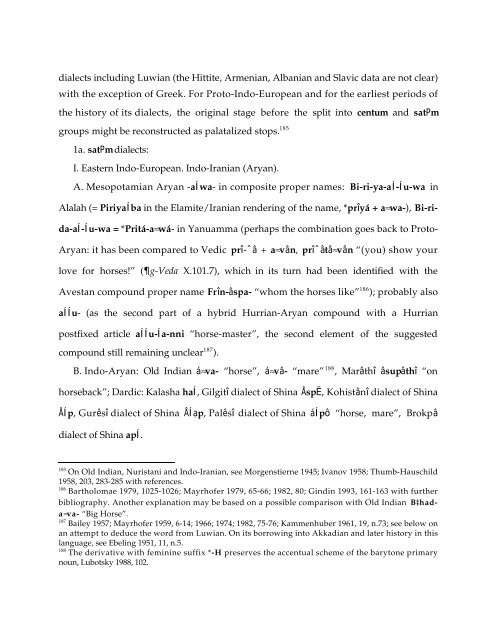Comparative Notes on Hurro-Urartian, Northern Caucasian
Comparative Notes on Hurro-Urartian, Northern Caucasian
Comparative Notes on Hurro-Urartian, Northern Caucasian
Create successful ePaper yourself
Turn your PDF publications into a flip-book with our unique Google optimized e-Paper software.
dialects including Luwian (the Hittite, Armenian, Albanian and Slavic data are not clear)<br />
with the excepti<strong>on</strong> of Greek. For Proto-Indo-European and for the earliest periods of<br />
the history of its dialects, the original stage before the split into centum and satPm<br />
groups might be rec<strong>on</strong>structed as palatalized stops. 185<br />
1a. satPm dialects:<br />
I. Eastern Indo-European. Indo-Iranian (Aryan).<br />
A. Mesopotamian Aryan -aÍwa- in composite proper names: Bi-ri-ya-aÍ-Íu-wa in<br />
Alalah (= PiriyaÍba in the Elamite/Iranian rendering of the name, *prîyá + a≈wa-), Bi-ri-<br />
da-aÍ-Íu-wa = *Pritá-a≈wá- in Yanuamma (perhaps the combinati<strong>on</strong> goes back to Proto-<br />
Aryan: it has been compared to Vedic prî-ˆâ + a≈vân, prîˆâtâ≈vân “(you) show your<br />
love for horses!” (g-Veda X.101.7), which in its turn had been identified with the<br />
Avestan compound proper name Frîn-âspa- “whom the horses like” 186 ); probably also<br />
aÍÍu- (as the sec<strong>on</strong>d part of a hybrid Hurrian-Aryan compound with a Hurrian<br />
postfixed article aÍÍu-Ía-nni “horse-master”, the sec<strong>on</strong>d element of the suggested<br />
compound still remaining unclear 187 ).<br />
B. Indo-Aryan: Old Indian á≈va- “horse”, á≈vâ- “mare” 188 , Marâthî âsupâthî “<strong>on</strong><br />
horseback”; Dardic: Kalasha haÍ, Gilgitî dialect of Shina ÅspË, Kohistânî dialect of Shina<br />
ÅÍp, Gurêsî dialect of Shina ÅÍa`p, Palêsî dialect of Shina áÍpô “horse, mare”, Brokpâ<br />
dialect of Shina apÍ.<br />
185 On Old Indian, Nuristani and Indo-Iranian, see Morgenstierne 1945; Ivanov 1958; Thumb-Hauschild<br />
1958, 203, 283-285 with references.<br />
186 Bartholomae 1979, 1025-1026; Mayrhofer 1979, 65-66; 1982, 80; Gindin 1993, 161-163 with further<br />
bibliography. Another explanati<strong>on</strong> may be based <strong>on</strong> a possible comparis<strong>on</strong> with Old Indian B‡hada≈va-<br />
“Big Horse”.<br />
187 Bailey 1957; Mayrhofer 1959, 6-14; 1966; 1974; 1982, 75-76; Kammenhuber 1961, 19, n.73; see below <strong>on</strong><br />
an attempt to deduce the word from Luwian. On its borrowing into Akkadian and later history in this<br />
language, see Ebeling 1951, 11, n.5.<br />
188 The derivative with feminine suffix *-H preserves the accentual scheme of the baryt<strong>on</strong>e primary<br />
noun, Lubotsky 1988, 102.





